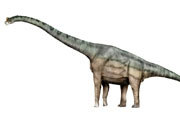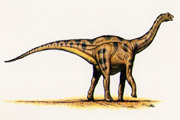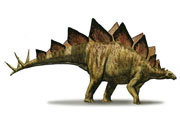Tyrannosaurus Rex was 46 feet long, 18 feet high, with sharp seven-inch long teeth. Some say he could chase his prey across an open field at speeds of 40 miles per hour. When Tyrannosaurus Rex caught his meal it took only one bite from his massive jaws to snap their backbones. This dude was scary.
The Preditor
It's obvious Tyrannosaurus Rex was scary in height, weight and length, but how deadly was it? No one can come to an agreement over how active T-Rex really was. Fast runner - slow runner? Hunter - scavenger? No one is entirely sure. Most scientists believe Tyrannosaurus Rex chased down his prey, but others think he was a scavenger and ate already dead animals. T-Rex's scrawny front arms didn't look like they could hold a victim during an attack, but then again, the Great White Shark has no problem catching a meal with no arms at all.
 Tyrannosaurus Rex have tiny arms!!
Tyrannosaurus Rex have tiny arms!!
Does Size Matter?
When you think about size and the Tyrannosaurus Rex - think jaws. Tyrannosaurus Rex's four foot long jaws had 50 to 60 thick, bone-crunching teeth, which were over 9 inches long. That's about the size of a big banana. One T-Rex was found with 13-inch long teeth. This guy could eat up to 500 pounds of meat and bones in one bite! A lot of people think Tyrannosaurus Rex is the biggest carnivorous dino, but Giganotosaurus and Carcharodontosaurus are slightly bigger.
 Skeleton of a Tyrannosaurus Rex
Skeleton of a Tyrannosaurus Rex
The Story of Sue, Sue and the Sioux
In 1990, the largest, most complete and best preserved Tyrannosaurus Rex was discovered by fossil hunter Sue Hendrickson in the Badlands of South Dakota. It took five years to settle who Sue (as the Tyrannosaurus Rex was also named) belonged to. To dig up dinosaur bones the landowner's permission is always needed. In Sue's case it was unclear who the real land owner was because the bones were found on land that was part of a Sioux (also pronounced "Sue") Indian reservation, but belonged to a private rancher. To complicate things more, the rancher was part Sioux and his land was held in trust by the US government. So what did they do? They sued, of course! In the end a judge decided Sue (the dino) was held in trust by the US government for the rancher. He decided to sell the T-Rex at a public auction. In New York, on October 4, 1997, Sue was purchased for nearly $8.4 million by The Field Museum - the most money ever paid for a fossil.
Setting the Record Straight
Tyrannosaurus Rex did not live during the Jurassic period, which means, yes, the movie is incorrect. It lived millions of years later, during the late Cretaceous period, roughly 65 to 85 million years ago.
Related Stories:
- Triceratops as Pets
- Stegs, the Mysterious Dino
- Ankylosaurus: One 'Fused' Dino
- More Dangerous Dinosaurs

































